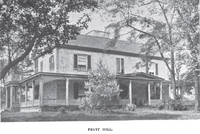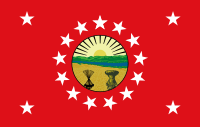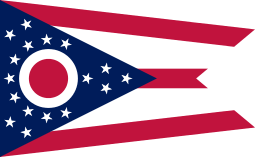William Allen (governor)
| William Allen | |
|---|---|
 | |
| 31st Governor of Ohio | |
|
In office January 12, 1874 – January 10, 1876 | |
| Lieutenant | Alphonso Hart |
| Preceded by | Edward F. Noyes |
| Succeeded by | Rutherford B. Hayes |
| United States Senator from Ohio | |
|
In office March 4, 1837 – March 3, 1849 | |
| Preceded by | Thomas Ewing |
| Succeeded by | Salmon P. Chase |
| Member of the U.S. House of Representatives from Ohio's 7th district | |
|
In office March 4, 1833 – March 3, 1835 | |
| Preceded by | Samuel Finley Vinton |
| Succeeded by | William K. Bond |
| Personal details | |
| Born |
December 18 or 27, 1803 Edenton, North Carolina |
| Died |
July 11, 1879 (aged 75) Fruit Hill, Chillicothe, Ohio |
| Political party | Democratic |
| Spouse(s) | Effie McArthur |
William Allen (December 18 or 27, 1803 – July 11, 1879) was a Democratic Representative, Senator and 31st Governor of Ohio.
Early life and family
Allen was born in Edenton, North Carolina and moved to Chillicothe, Ohio in 1819, after his parents' death. He was of Quaker ancestry.[1]
Allen and his sister Mary Granberry Allen lived in Chillicothe together. His sister married Reverend Pleasant Thurman, and their son, Allen G. Thurman, followed in his uncle's footsteps, becoming a lawyer and politician.
Allen attended Chillicothe Academy before studying law with Colonel Edward King. He was admitted to the bar in Ohio at age 21.[1] He began his career as a politician in the Democratic Party at a young age.[2]
Career

Allen served as United States Representative from Ohio from 1833 to 1835, losing his bid for re-election. He served as United States Senator from Ohio from 1837 to 1849, losing a bid for a third term in 1848.
While in the Senate, Allen was one of a group of Western Democrat expansionists who asserted that the U.S. had a valid claim to the entire Oregon Country, which was an issue during the 1844 U.S. presidential election. He suggested that the United States should be prepared to go to war with the United Kingdom in order to annex the entire Oregon Country up to Russian-owned Alaska at latitude 54°40′N. This position ultimately produced the slogan "Fifty-Four Forty or Fight!," coined in 1846 by opponents of such a policy (not, as popularly believed, a slogan in the 1844 Presidential campaign).[3] Allen supported "popular sovereignty" and the presidential candidacy of fellow-Democrat Lewis Cass in 1848.[1]
In 1849, Allen retired to his farm, "Fruit Hill", which had belonged to his father-in-law, and fellow Ohio Governor, Duncan McArthur,[2] near Chillicothe, Ohio. Allen identified himself as a "Peace Democrat" by opposing the American Civil War.[1] Allen did not return to public service for nearly a quarter century, until he served as Governor of Ohio from 1874 to 1876. He unsuccessfully sought a second two-year term in an 1875 election.
Allen was noted for his loud voice. A friend asked Senator Benjamin Tappan if a fellow Ohioan was still in Washington. Tappan replied "No, he left yesterday and is probably by this time in Cumberland, Maryland, but if you will go to Bill Allen and tell him to raise that window and call him he will come back."[4]
Death
At the close of his administration, he retired to private life at Fruit Hill, where he died in 1879.[5] Allen is buried at Grandview Cemetery, Chillicothe.[6]
Legacy
Allen County, Kansas is named for William Allen.[7]
In 1887, Ohio donated a statue of Allen to the National Statuary Hall Collection, which was exhibited in the National Statuary Hall of the U.S. Capitol. The statue was sculpted by Charles H. Niehaus.[8]
In 2010, the Ohio Historical Society held a statewide poll on the suitability of Allen as a distinguished representative of the state. The poll found that many Ohioans objected to Allen. On August 26, the Ohio National Statuary Committee voted to replace Allen's statue with a statue of Ohio-born inventor Thomas A. Edison. The Ohio General Assembly agreed to replace the statue in part because "Allen’s pro-slavery position and outspoken criticism of President Abraham Lincoln during the Civil War make him a poor representative for Ohio in the U.S. Capitol."[9] However, lack of funding for the Edison statue delayed replacement of the Allen statue.[10] The Edison statue was completed in spring 2015, and was replaced September 20th, 2016.[11] The statue of Allen was relocated to the Ross County Heritage Center in Chillicothe.[12]
References
- 1 2 3 4 "William Allen". Ohio History Central. Retrieved August 5, 2012.
- 1 2 Ryan, Daniel J (1888). "William Allen". A History of Ohio with Biographical Sketches of her Governors and the Ordinance of 1787. Columbus, Ohio: A H Smythe. pp. 190–191.
- ↑ "William Allen". Architect of the Capital. Retrieved August 5, 2012.
- ↑ Hunter, W.H. (1898). "The Pathfinders of Jefferson County". Ohio Archaeological and Historical Publications. VI: 226.
- ↑ Renick, L W; Fullerton, M D; Nipgen, M P (1896). Che-le-co-the, glimpses of yesterday: a souvenir of the hundredth anniversary of the founding of Chillicothe, Ohio April 1896. Chillicothe. p. 76.
- ↑ "Grandview Cemetery". Grandview Cemetery. Retrieved July 29, 2012.
- ↑ "Profile for Allen County, Kansas, KS". ePodunk. Retrieved August 5, 2012.
- ↑ The National Statuary Hall Collection
- ↑ Legacy for Ohio
- ↑ "Inventive fundraising is called for Edison's statue." Columbus Dispatch, January 13, 2013, Page 2B
- ↑ "Ohioans can visit statue before it heads to D.C." Columbus Dispatch, May 20, 2015, Page 9B
- ↑ "Heritage Center gets historic statue" Chillicothe Gazette, September 23, 2016, Page A1
External links
- United States Congress. "William Allen (id: A000150)". Biographical Directory of the United States Congress.
- National Statuary Hall Collection: William Allen at Architect of the Capitol
- William Allen at Ohio History Central
- William Allen at Find a Grave
-
 "Allen, William (statesman)". Appletons' Cyclopædia of American Biography. 1900.
"Allen, William (statesman)". Appletons' Cyclopædia of American Biography. 1900.



